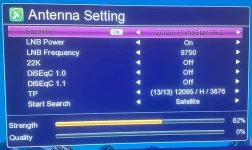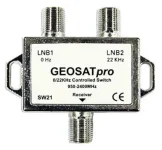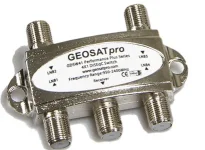I got two KU band dishes set up. One is 90cm and motorized. The other is 100cm and the dishe mount assemply is mounted on the top of the pole and faces 99.2W permanently.
I acquired a 22Khz Controlled Switch. Specs:
Insertation Loss: 3db
Power Passing: 500mA Max
Frequesncy Range: 950-24ooMhz
Here is how the Lnbs are coupled to the switch:
LNB 1 (0 HZ) - Dish pointing permanently at 99.2W
LNB 2 (22KHz) - Motorized dish
I wired everything up and did a scan on LNB 1 and only picked up Montana PBS and got one 'wild feed' of a car show in Lousiana. I tried LNB 2 and all worked accordingly.
I then checked my settings for LNB 1 (EG PrimeStar 99.2) and everythnig was perfect!
The Koqit stb I have will not allow me to have the setting so that 9750/10600 is active with 22K set to off. There is no way to enforce this setting this way.
As you analyse the pics you'll see this. INFOWARS on 12095 will not be picked up on 9750 but when the LNB frequency is changed to 9750/10600 it gets picked up. But then the switch will not work as intended.
The only conclusion I can seem to arrive at is:
1. The switch must be faulty.
2. It seems at the moment that were the firmware to allow 9750/10600 to be active with 22K in the 'Off' position this may work, but again this isn't an option.
3. I disconnected the cables from the switch and then coupled the coax so LNB 1 would go straight to the stb. I then did a blind scan and picked up all the channels on 99.2. I then reconnected everything to see if pre-scanned channels on LNB 1 would now get picked up and that failed as well. Actually, I can only see Montana PBS, and wild feeds BJCA New Orleans on 11750/H/1499 and WSAV Unit 9 on 11786/V/5834. The known channels did not appear. Just Montana PBS.
So what are your thoughts?
Thanks for reading and stopping by!


I acquired a 22Khz Controlled Switch. Specs:
Insertation Loss: 3db
Power Passing: 500mA Max
Frequesncy Range: 950-24ooMhz
Here is how the Lnbs are coupled to the switch:
LNB 1 (0 HZ) - Dish pointing permanently at 99.2W
LNB 2 (22KHz) - Motorized dish
I wired everything up and did a scan on LNB 1 and only picked up Montana PBS and got one 'wild feed' of a car show in Lousiana. I tried LNB 2 and all worked accordingly.
I then checked my settings for LNB 1 (EG PrimeStar 99.2) and everythnig was perfect!
The Koqit stb I have will not allow me to have the setting so that 9750/10600 is active with 22K set to off. There is no way to enforce this setting this way.
As you analyse the pics you'll see this. INFOWARS on 12095 will not be picked up on 9750 but when the LNB frequency is changed to 9750/10600 it gets picked up. But then the switch will not work as intended.
The only conclusion I can seem to arrive at is:
1. The switch must be faulty.
2. It seems at the moment that were the firmware to allow 9750/10600 to be active with 22K in the 'Off' position this may work, but again this isn't an option.
3. I disconnected the cables from the switch and then coupled the coax so LNB 1 would go straight to the stb. I then did a blind scan and picked up all the channels on 99.2. I then reconnected everything to see if pre-scanned channels on LNB 1 would now get picked up and that failed as well. Actually, I can only see Montana PBS, and wild feeds BJCA New Orleans on 11750/H/1499 and WSAV Unit 9 on 11786/V/5834. The known channels did not appear. Just Montana PBS.
So what are your thoughts?
Thanks for reading and stopping by!





